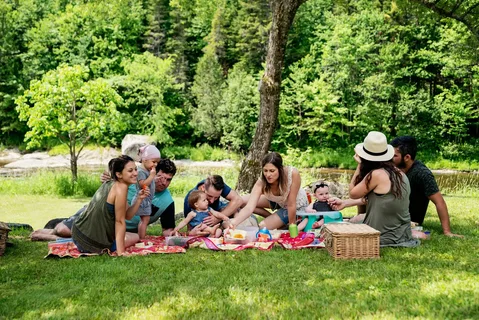Starting a picnic business is an amazing business idea if you’re looking for a way to increase your income.
Do you enjoy organizing events and creating memorable experiences? Imagine the rustling of leaves, the gentle breeze, and the soothing sun on your skin as you lay out a spread of delectable treats on a vibrant picnic blanket.
The joy of picnicking has always captured the essence of relaxation and connection with nature. Starting a picnic business could be a wonderful venture.
In this guide, we’ll walk you through the steps to turn your love for picnics into a thriving business.
What is a Picnic?
It is a time when a packed lunch is consumed outside, particularly when visiting the countryside.

Guidelines for Starting a Picnic Business
Step 1:
Market Research and Planning
Before diving in, it’s essential to conduct thorough market research. Identify your target audience, potential competitors, and the demand for picnic experiences in your area.
Understand the preferences of your potential customers – whether they are looking for romantic setups, family-friendly picnics, or corporate outings. This research will guide your business’s direction and help you tailor your offerings to meet the needs of your customers.
Step 2:
Define Your Niche
Differentiate your picnic business by focusing on a specific niche. This could be based on themes (e.g., vintage, beach, rustic), occasions (e.g., birthdays, anniversaries), or dietary preferences (e.g., vegan, gluten-free).
Defining a unique selling point will not only attract customers but also set you apart from competitors.
Step 3:
Legalities and Logistics
Starting any business involves legalities. Depending on your location, you may need to register your business, obtain necessary permits, and adhere to health and safety regulations.
Additionally, consider liability insurance to protect your business against any unforeseen circumstances during your picnic events.
Step 4:
Design Creative Packages
Craft a range of packages that cater to different customer needs. Your packages could include picnic setups, food and beverage options, seating arrangements, and possibly entertainment. Ensure that your packages are flexible and customizable to suit varying preferences and budgets.
Step 5:
Sourcing Suppliers
Establish relationships with local suppliers for your food, beverages, and picnic equipment. Emphasize quality and freshness in your offerings. You could partner with local bakeries, delis, and farmers’ markets to source fresh, locally-produced items.
This not only supports your community but also adds an authentic touch to your picnic experiences.
Step 6:
Create Your Branding and Marketing Strategy
Your branding should reflect your company’s values, vision and mission. Creating a consistent brand identity is key to marketing your business effectively. Plan your marketing strategy by targeting your audience through social media advertising, local listings and partnerships.
Step 7:
Creating Memorable Setups
The ambiance of your picnic setups will play a pivotal role in attracting customers. Pay attention to details like comfortable seating, aesthetically pleasing decor, and thoughtful arrangements. Incorporate elements like cushions, blankets, fairy lights, and tableware that align with your chosen theme or niche.

Step 8:
Design Your Picnic Experience
What will guests experience when they attend your picnic? Will you offer different themes or packages? How will you decorate your event space? These are all questions you need to consider when designing the perfect picnic experience.
You may also need to hire staff and source equipment such as tables, chairs, and umbrellas.
Step 9:
Plan Your Menu
Food is at the heart of a successful picnic business. Develop a menu that complements your business concept and target audience. Will you offer pre-prepared food, or will you prepare fresh food on-site? Make sure to take any dietary restrictions into account and provide options that cater to all tastes.
Step 10:
Building an Online Presence
Create a user-friendly website showcasing your services, packages, and pricing. High-quality photos of your past picnic setups will give potential customers a glimpse of the experiences you offer. Leverage social media platforms to share visually appealing content, engage with your audience, and run promotions.
Step 11:
Marketing and Networking
Utilize both online and offline marketing strategies to spread the word about your picnic business. Collaborate with local event planners, photographers, and venues to expand your network. Offer discounts or special packages to your first few clients to gather positive reviews and testimonials.
Step 12:
Customer Experience and Feedback
Deliver exceptional customer service to create lasting impressions. Pay attention to feedback and continuously improve your services based on customer suggestions. One of the best marketing strategies is positive word-of-mouth.
Step 13:
Scaling and Innovation
As your picnic business gains momentum, consider expanding your offerings. You could introduce add-ons like games, workshops, or even eco-friendly practices to align with the growing demand for sustainable experiences.
Step 14:
Launch Your Picnic Business
After completing the above steps, you are ready to launch your picnic business. Celebrate your launch and invite local influencers or bloggers to review your event. Stir up excitement and interest through creative promotion strategies, Instagram or Facebook live feeds and perhaps giveaways.
Starting a picnic business can be a rewarding and profitable venture with the right upfront planning and execution. With the rise of experiential activities and demand for outdoor events, it’s a great time to invest in creating a memorable and unique picnicking experience. Good luck on your picnic business journey!
Conclusion
Starting a picnic business is not just about providing food and a beautiful setting; it’s about curating unforgettable moments in the great outdoors.
By combining your passion for picnics with solid planning, creativity, and exceptional customer service, you can embark on a journey to bring joy, relaxation, and connection to individuals and groups in search of unique outdoor experiences.
See More:





